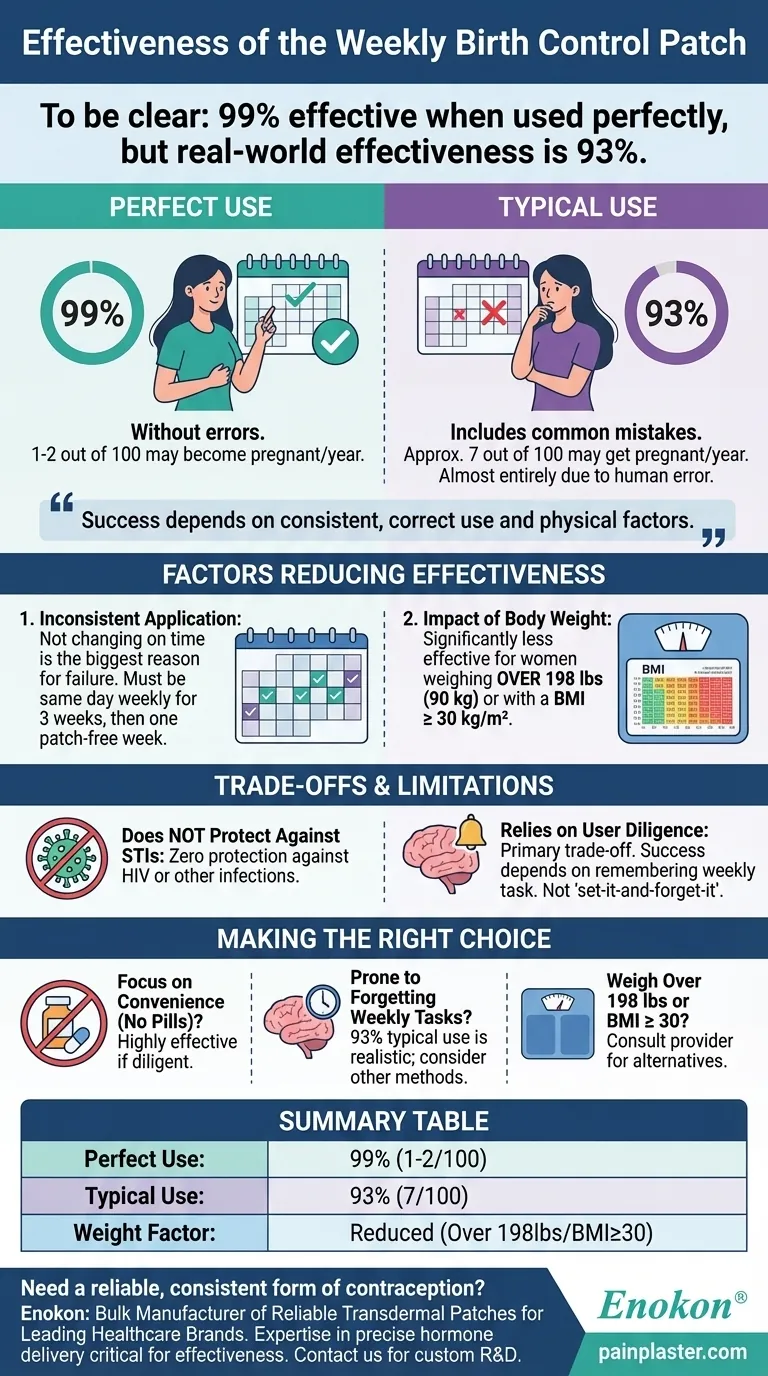To be clear, the weekly prescription birth control patch is 99% effective at preventing pregnancy when used perfectly and exactly as directed. However, its real-world effectiveness is closer to 93% because people can make mistakes, such as forgetting to change the patch on time. This difference is critical to understanding your actual level of protection.
The birth control patch is an excellent contraceptive method, but its effectiveness in your life will depend entirely on your ability to use it consistently and correctly, and on certain physical factors.

Deconstructing Effectiveness: Perfect vs. Typical Use
To make an informed decision, you must understand the two numbers used to measure effectiveness. They tell very different stories about how a contraceptive method performs.
The "Perfect Use" Standard
The 99% effectiveness rate comes from controlled clinical trials. In these studies, participants use the patch perfectly, without any errors.
This means that under ideal conditions, only about 1 to 2 out of every 100 women using the patch may become pregnant in the first year.
The "Typical Use" Reality
The 93% effectiveness rate reflects how people use the patch in the real world, which includes common mistakes.
This "typical use" rate means that approximately 7 out of every 100 patch users may get pregnant each year. The difference is almost entirely due to human error.
Factors That Reduce Patch Effectiveness
The gap between perfect and typical use is created by specific, avoidable issues. Being aware of them is the key to ensuring the patch works as intended for you.
Inconsistent Application
The single biggest reason for failure is not changing the patch on the correct day. The patch must be changed on the same day each week for three consecutive weeks, followed by a patch-free week.
The Impact of Body Weight
The patch may be significantly less effective for women who weigh more than 198 lbs (90 kg).
Healthcare providers generally advise against using the patch if your Body Mass Index (BMI) is 30 kg/m² or higher due to this reduced effectiveness.
Understanding the Trade-offs and Limitations
No birth control method is without its own set of considerations. Objectivity requires looking at the full picture.
It Does Not Protect Against STIs
It is critical to remember that the birth control patch offers zero protection against HIV (the virus that causes AIDS) or any other sexually transmitted infections (STIs).
The Method Relies on You
The patch's primary trade-off is its reliance on user diligence. Unlike "set-it-and-forget-it" methods like an IUD or implant, its success depends on your ability to remember a weekly task.
Making the Right Choice for Your Goal
- If your primary focus is convenience without daily pills: The patch can be a highly effective option, provided you are diligent with your weekly schedule and meet the physical criteria.
- If you know you are prone to forgetting weekly tasks: The 93% "typical use" rate is a more realistic expectation, and you may want to discuss more foolproof methods with your doctor.
- If you weigh over 198 lbs (90 kg) or have a BMI of 30 or more: You should consult your healthcare provider about alternative birth control methods that will be more effective for you.
Ultimately, choosing the right contraception is a personal decision made with a clear understanding of the facts and in partnership with your doctor.
Summary Table:
| Effectiveness Metric | Rate | Key Takeaway |
|---|---|---|
| Perfect Use | 99% | Only 1-2 out of 100 women may get pregnant yearly when used exactly as directed. |
| Typical Use | 93% | About 7 out of 100 women may get pregnant yearly, accounting for common human errors. |
| Key Factor: Weight | Reduced Effectiveness | Significantly less effective for women weighing over 198 lbs (90 kg) or with a BMI ≥ 30. |
Need a reliable, consistent form of contraception? The effectiveness of any method depends on the quality and consistency of the product itself. At Enokon, we are a bulk manufacturer of reliable transdermal patches for leading healthcare and pharmaceutical brands. Our technical expertise ensures precise, consistent hormone delivery, which is critical for contraceptive effectiveness. If you are a distributor or brand looking for a trusted partner for custom R&D and development of high-quality transdermal patches, contact our experts today to discuss how we can support your product line with dependable, effective solutions.
Visual Guide

Related Products
- Heating Pain Relief Patches for Menstrual Cramps
- Prostate Pain Kidney Health Care Patch for Men
- Far Infrared Pain Patch Relief Pain Reliever for Back
- Capsaicin Chili Medicated Pain Relief Patches
- Menthol Gel Pain Relief Patch
People Also Ask
- What types of pain can the Deep Heat Pain Relief Back Patch be used for? Targeted Relief for Muscles & Joints
- How does the Deep Heat Back Patch work? A Drug-Free Solution for Targeted Pain Relief
- How do Deep Heat Pain Relief Patches provide pain relief? Discover the Drug-Free Mechanism
- How quickly does the Deep Heat Pain Relief Back Patch activate and how long does it provide warmth? Get 16-Hour Relief
- How often should HRT patches be changed? Optimize Your Hormone Therapy Schedule














